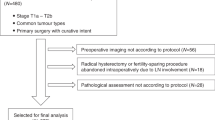Abstract
Either diagnostic delay or tumour biology are possible factors governing the degree of spread at diagnosis of cervical cancer. To try to identify the most important parameter contributing to advanced stage, the duration of symptoms were recorded from patients scheduled for radiotherapy (n = 141) or radical hysterectomy (n = 36). In 146 cases tumour proliferation rates were evaluated following in vivo labelling with the DNA precursor BrdUrd. For symptomatic patients there was no association between duration of symptoms and stage at presentation. There was a significant trend for patients with increasing tumour stage to have more rapidly proliferating tumours with higher mean labelling index (LI) measurements (P = 0.001) and a shorter mean potential doubling time (Tpot) (P = 0.023). Socio economic deprivation may be associated with shorter Tpot values. The conclusion from this data is that stage at diagnosis is more dependent on the biological behaviour of the tumour, as expressed by proliferation rates, than delay in presentation. © 2000 Cancer Research Campaign
Similar content being viewed by others
Article PDF
Change history
16 November 2011
This paper was modified 12 months after initial publication to switch to Creative Commons licence terms, as noted at publication
References
Bartsch D, Boye B, Baust Çzur Hausen H & Schwarz E (1992) Retinoic acid-mediated repression of human papilloma virus 18 transcription and different ligand regulation of the retinoic acid receptor beta gene in non tumorigenic and tumorigenic Hela hybrid cells. EMBO J 22: 83–91
Bolger BS, Cooke TG, Symonds RP, MacLean AB & Stanton PD (1993) Measurement of cell kinetics in cervical tumours using bromodeoxyuridine. Br J Cancer 68: 166–171
Bolger BS, Symonds RP, MacLean AB, Stanton PD, Cooke TG, Burnett P & Kelly P (1996) Prediction of radiotherapy response of cervical carcinoma through measurement of proliferation rate. Br J Cancer 74: 1223–1226
Carstairs V & Morris R (1991) Deprivation and Health in Scotland. Aberdeen University Press: Aberdeen
Coleman MP, Babb P, Damiecki P, Grosclaude P, Honjo S, Jones J, Gerhjardt K, Picard A, Quinn M, Sloggett A & De Stavola B (1999) Cancer Survival trends in England and Wales: Deprivation and NHS Region Office for National Statistics. 88–100, HMSO: London
Dhooge IJ, Albers FWJ & van Cauwenberge PB (1996) Clinical characteristics and diagnostic delay of head and neck cancer: results from a prospective study in Belgium. Eur J Surg Oncol 23: 354–358
Eckhert RL, Agrawal C, Hembree JR, Choo CK, Sizemore N, van Leyen SA & Rorke EA (1995) Human Cervical Cancer: Retinoids, interferon and human papilloma virus. Adv Exp Med Biol 375: 31–44
Lamont DW, Symonds RP, Brodie MM, Nwabineli & Gillis CR (1993) Age, socio-economic status and survival from cancer of cervix in the west of Scotland 1980–1987. Br J Cancer 67: 351–357
Lombard I Soloman AV, Validire P, Zafrandi B, de la Rochefordiere A, Clough K, Farre M, Pouillart P & Sastre-Garau X (1998) Human papilloma virus genotype as a major determinant of the course of cervical cancer. J Clin Oncol 16: 2613–2619
Obermair A, Hanzal E, Schreiner-Frech I, Buxbaum P, Bancher-Todesca D, Thoma M, Kurz C, Vavra N, Gitsch G & Svelda P (1996) Influence of delay on established prognostic factors in endometrial cancer. Anticancer Res 16: 947–950
Palan PR, Chang CJ, Mikhail MS, Ho GYF, Basu J & Romney SL (1998) Plasma concentrations of micronutrients during a nine month clinical trial of beta carotene in women with precursor cervical cancer lesions. Nutr Cancer 301: 46–52
Serur E, Fruchter RG, Maiman M, McGuire J, Arrastia CD & Gibbon MD (1995) Age, substance abuse and survival of patients with cervical carcinoma. Cancer 75: 2530–2538
Tsang RW, Wong CS, Fyles AW, Levin W, Manchal LA, Milosevic M, Chapman W, Li Y & Pintilie M (1999) Tumour proliferation and apoptosis in human cervix carcinoma II: correlation with clinical outcome. Radiother Oncol 50: 93–101
Wilson GD, Dische S & Saunders MI (1995) Studies with bromodeoxyuridine in head and neck cancer and accelerated radiotherapy. Radiother Oncol 36: 189–197
Author information
Authors and Affiliations
Rights and permissions
From twelve months after its original publication, this work is licensed under the Creative Commons Attribution-NonCommercial-Share Alike 3.0 Unported License. To view a copy of this license, visit http://creativecommons.org/licenses/by-nc-sa/3.0/
About this article
Cite this article
Symonds, P., Bolger, B., Hole, D. et al. Advanced-stage cervix cancer: rapid tumour growth rather than late diagnosis. Br J Cancer 83, 566–568 (2000). https://doi.org/10.1054/bjoc.2000.1336
Received:
Revised:
Accepted:
Published:
Issue date:
DOI: https://doi.org/10.1054/bjoc.2000.1336
Keywords
This article is cited by
-
The effects of time valuation in cancer optimal therapies: a study of chronic myeloid leukemia
Theoretical Biology and Medical Modelling (2019)
-
Factors associated with late presentation of cervical cancer cases at a district hospital: a retrospective study
BMC Public Health (2018)
-
Socioeconomic inequalities in attending the mass screening for breast cancer in the south of the Netherlands—associations with stage at diagnosis and survival
Breast Cancer Research and Treatment (2011)
-
Prognostic implications of emergency admission and delays in patients with breast cancer
Supportive Care in Cancer (2009)
-
Delay in referral of oropharyngeal squamous cell carcinoma to secondary care correlates with a more advanced stage at presentation, and is associated with poorer survival
British Journal of Cancer (2006)



